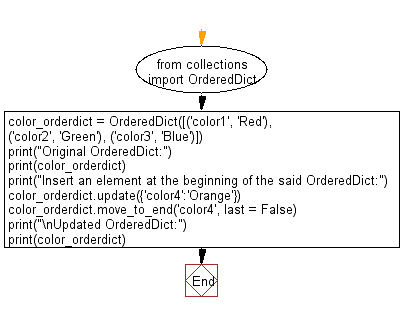Python: Insert an element at the beginning of a given OrderedDictionary
Python Collections: Exercise-22 with Solution
Write a Python program to insert an element at the beginning of a given OrderedDictionary.
Sample Solution:
Python Code:
from collections import OrderedDict
color_orderdict = OrderedDict([('color1', 'Red'), ('color2', 'Green'), ('color3', 'Blue')])
print("Original OrderedDict:")
print(color_orderdict)
print("Insert an element at the beginning of the said OrderedDict:")
color_orderdict.update({'color4':'Orange'})
color_orderdict.move_to_end('color4', last = False)
print("\nUpdated OrderedDict:")
print(color_orderdict)
Sample Output:
Original OrderedDict:
OrderedDict([('color1', 'Red'), ('color2', 'Green'), ('color3', 'Blue')])
Insert an element at the beginning of the said OrderedDict:
Updated OrderedDict:
OrderedDict([('color4', 'Orange'), ('color1', 'Red'), ('color2', 'Green'), ('color3', 'Blue')])
Flowchart:

Visualize Python code execution:
The following tool visualize what the computer is doing step-by-step as it executes the said program:
Python Code Editor:
Have another way to solve this solution? Contribute your code (and comments) through Disqus.
Previous: Write a Python program to count most and least common characters in a given string.
Next: Write a Python program to get the frequency of the tuples in a given list.
What is the difficulty level of this exercise?
Test your Python skills with w3resource's quiz
Python: Tips of the Day
Inverts a dictionary with non-unique hashable values:
Example:
def tips_collect_dictionary(obj):
inv_obj = {}
for key, value in obj.items():
inv_obj.setdefault(value, list()).append(key)
return inv_obj
ages = {
"Owen": 25,
"Jhon": 25,
"Pepe": 15,
}
print(tips_collect_dictionary(ages))
Output:
{25: ['Owen', 'Jhon'], 15: ['Pepe']}
- New Content published on w3resource:
- Scala Programming Exercises, Practice, Solution
- Python Itertools exercises
- Python Numpy exercises
- Python GeoPy Package exercises
- Python Pandas exercises
- Python nltk exercises
- Python BeautifulSoup exercises
- Form Template
- Composer - PHP Package Manager
- PHPUnit - PHP Testing
- Laravel - PHP Framework
- Angular - JavaScript Framework
- React - JavaScript Library
- Vue - JavaScript Framework
- Jest - JavaScript Testing Framework
